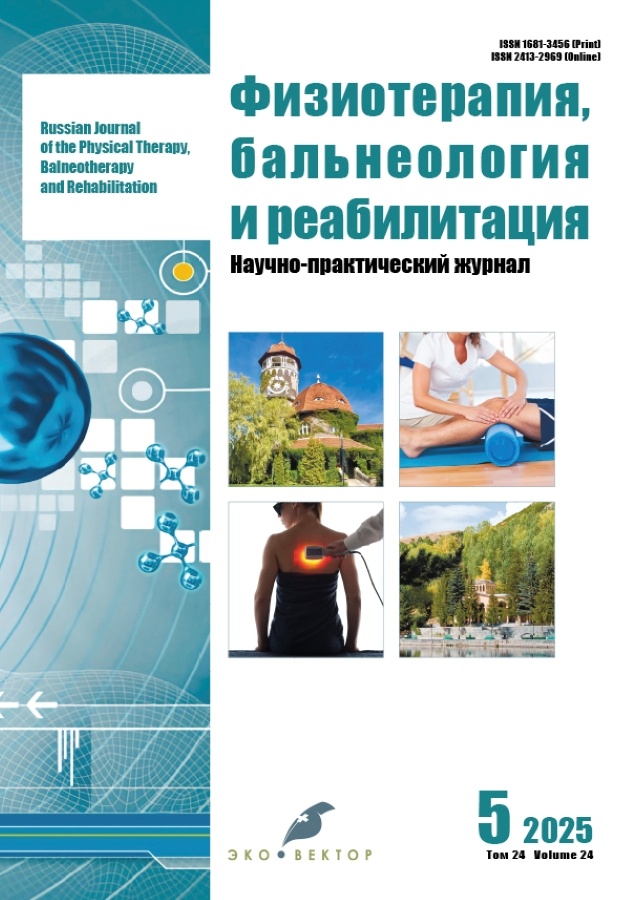卷 24, 编号 5 (2025)
Review
Therapeutic potential of hypoxic conditioning technology in post-stroke rehabilitation: from molecular and physiological mechanisms to clinical practice (narrative review)
摘要
急性脑血管意外(acute cerebrovascular accident, ACVA)仍是导致致残和死亡的主要原因之一,即使在恢复的晚期阶段,认知和功能障碍的发生和进展风险依然存在。问题的严重性促使人们探索卒中后康复及改善患者生活质量的创新方法。间歇性缺氧治疗,尤其是以间歇性低氧-高氧暴露(intermittent hypoxic–hyperoxic training, IHHT)疗程形式,作为一种前景广阔的非药物治疗方法,能够促进神经可塑性、突触生成和脑血流动力学。本文旨在分析IHHT在ACVA后康复中的治疗潜力,特别是其在分子适应机制、血管生成和功能恢复方面的作用。本研究方法包括在PubMed、Scopus、eLIBRARY.RU等数据库中进行系统检索,重点关注与低氧预适应、神经保护和临床结局相关的研究。研究表明,IHHT可激活HIF-1α依赖性信号通路,通过VEGF促进血管生成,并通过BDNF诱导神经发生,实验与临床数据均对此提供了支持。中等强度的间歇性低氧(9–16% O2)可优化氧化还原平衡,抑制促炎细胞因子(IL-6、TNF-α)的表达,并通过Nrf2途径增强抗氧化防御,其作用与缺血性损伤体积的减少相关。在临床方面,IHHT可改善认知功能(记忆、注意力)和运动能力,尤其是在结合有氧训练时,可显著提高运动耐力(6分钟步行测试距离提高15–20%)和生活质量。其心脏保护效应表现为血压的正常化及氧化应激标志物(如丙二醛)水平的下降,对多病共存的患者尤为重要。将IHHT纳入多模式康复方案有助于增强方法间的协同作用,促进神经血管重塑。尽管该技术前景广阔,但仍需根据年龄及合并症优化个体化方案,并开展随机对照试验以评估其长期安全性。本综述面向神经科医师、分子生物学家及康复医学专家,强调在进一步验证其疗效后,IHHT具有向临床实践转化的潜力。
 321-331
321-331


Features of management and clinical course of the early rehabilitation period after acute coronary syndrome
摘要
急性冠状动脉综合征(acute coronary syndrome, ACS)仍是全球范围内,尤其是在中低收入国家导致死亡和致残的主要原因之一。本文综述了ACS患者心脏康复(cardiac rehabilitation, CR)策略的最新进展,重点分析流行病学、临床特点及CR项目的创新策略。CR的关键组成包括体育锻炼、心理康复、饮食干预和药物治疗,这些措施均需个体化制定以优化临床结局。文章特别关注ACS在性别方面的临床差异、康复项目的可及性差异,以及COVID-19疫情对疾病动态的影响。综述了最新研究成果,强调将数字技术、远程医疗及移动应用整合至CR项目中的有效性。作者同时探讨了传统康复方法与新兴手段,如高强度间歇训练和地中海饮食,为康复项目的开发提供了理论基础。尽管CR的疗效已被证实,但由于患者依从性低及资源匮乏地区的可获得性不足,其推广仍面临诸多限制。目前正制定新的临床指南,以完善康复策略,降低复发性并发症风险,并提高患者生活质量。
 332-347
332-347


Original studies
Dynamic Electroneurostimulation and corrective therapeutic gymnastics in medical rehabilitation programs for children with scoliosis
摘要
论证:脊柱侧凸在儿童骨科疾病中具有较高的患病率(高达27.6%),在青少年中病程进展显著(50%),并可导致儿童早期致残(8–9%),这凸显了开发创新性医学康复方案的必要性。
目的:科学论证在儿童脊柱侧凸医学康复中联合应用动态神经电刺激与包含Katharina Schroth方法元素的矫正性治疗体操的合理性。
方法。纳入60名5–18岁II度脊柱侧凸患儿(男童36.7%,女童63.3%),采用随机前瞻性研究设计。所有患者通过随机化分为三组。主组接受动态神经电刺激(dynamic electroneurostimulation, DENS)与结合Schroth方法元素的矫正性治疗体操(therapeutic gymnastics, TG)的综合干预。第一对照组仅接受DENS;第二对照组仅接受结合Schroth方法元素的TG。
结果:在研究过程中发现,只有主组患儿在接受DENS与结合Schroth方法元素的TG的综合干预后,背部肌肉疲劳度减轻,且在静态和动态负荷下背痛强度下降。与单独接受DENS或LG的儿童相比,这些差异具有统计学意义(p <0.05)。在主组和第二对照组均记录到临床-骨科状态病理性改变的回退(p 0.05)。在主要组患者中,背部和腹部肌肉力量耐力中位数的增长表现出最为显著的动态变化。在脊柱侧弯测量的动态分析中,仅在主要组儿童中观察到胸椎指标的中位数显著增加(p<0.05)。胸椎激光多普勒血流监测的动态分析显示,微循环灌注中位数参数(M)的平均值和灌注变异性(σ)均升高,这种变化在接受DENS联合TG以及单独TG的患儿中更为显著。
结论:DENS可单独使用,也可与结合Schroth方法元素的TG联合应用于II度脊柱侧凸患儿。统计学分析显示(p <0.05),综合应用DENS与结合Schroth方法元素的TG的疗效为75.0%,显著高于单独TG(68.8%)或单独DENS(53.8%)。在所有组中,对41.6%患儿在治疗结束后3个月和6个月进行的随访观察显示,疗效指标得以保持。
 348-356
348-356


Novel statistical data processing approach for evaluating rehabilitation effectiveness in children with hemiparetic cerebral palsy
摘要
BACKGROUND: Gait disturbances are a key factor contributing to disability in children with cerebral palsy. Conventional scales and group-based statistical tests poorly capture small but clinically significant improvements after rehabilitation. This highlights the need for new methods of objective evaluation of rehabilitation effectiveness.
AIM: The work aimed to compare the performance of an individualized statistical method of magnitude-based decisions in interpreting instrumented gait analysis data obtained with inertial sensors for assessing rehabilitation effectiveness in children with hemiparetic cerebral palsy, with conventional group statistical approaches (p-value).
METHODS: This was an observational, single-center, prospective, continuous study. It was based on the analysis of instrumented gait analysis with inertial sensors protocols performed before and after a rehabilitation course in children aged 8–17 years with hemiparetic cerebral palsy at the Department of Pediatric Medical Rehabilitation, Russian Children’s Clinical Hospital.
RESULTS: In a cohort of 23 children with hemiparetic cerebral palsy, the standard paired t-test did not reveal statistically significant group changes in spatiotemporal gait parameters (p > 0.05 for all indicators). However, individualized MBD analysis recorded clinically significant positive changes in most patients: increased step velocity and cycle length on the paretic side (in 47% and 33% of cases, respectively), greater ranges of motion in the knee (67%) and ankle (40%) joints, improved foot clearance (47%), as well as reduced pathological compensations in the lumbosacral region (53%). Thus, the MBD method demonstrated greater sensitivity to individual rehabilitation effects, detecting improvements that remained unnoticed with the classical group-based approach.
CONCLUSION: Individualized MBD analysis makes it possible to objectively register clinically significant improvements in gait that are not detected by conventional group tests, thereby justifying its use for evaluating rehabilitation effectiveness.
 357-370
357-370


Neuroimaging markers of safety of physical therapy exercises in children with muscular dystrophies
摘要
方法:本研究纳入86例基因学确诊的杜氏肌营养不良(Duchenne muscular dystrophy, DMD)患儿(平均年龄7.5±2.4岁)及42例肢带型肌营养不良(limb-girdle muscular dystrophies, LGMD)患儿(平均年龄11.8±3.3岁)。所有患者均接受为期4个月的医学康复课程,其中包括PT练习的组合:有氧训练、肌肉牵伸练习以及功率自行车训练。安全性评估涵盖临床、实验室和神经影像学指标。
结果:MRI检查显示,两组患者在完成无负荷有氧运动后,骨盆带、肩带、大腿及小腿主要肌群的 水相关T2信号 未见统计学显著升高,提示未出现炎症或水肿加重。所有不良事件均表现为轻微、短暂的症状,对康复过程无明显影响,也 无需额外的药物或非药物治疗。共记录到8例因进行向心或离心运动导致的骨骼肌损伤。在DMD患儿组,骨骼肌在运动前的信号强度在动态随访中分别为34.9±1.0和44.1±3.7 ms(p <0.01)。在LGMD患儿组,信号强度分别为33.6±2.3和44.3±4.1 ms(p <0.01)。
结论:本研究所制定的康复方案,包括无负荷有氧运动,不会导致不同类型肌营养不良患儿骨骼肌损伤,这一点已通过神经影像学、临床和实验室方法证实。在DMD患儿中,骨骼肌来源于水分的MR信号平均增加20.4±5.8%,而在LGMD患儿中则增加23.8±6.3%。这种增加具有临床意义,提示骨骼肌损伤并伴有相应的症状表现。
 371-382
371-382


Fractional laser photothermolysis for early correction of ecchymoses: development of an effective therapeutic protocol
摘要
目的:对应用波长为(10 600 nm)、L型脉冲的CO2点阵激光进行光热分解治疗瘀斑的科学依据进行论证,并制定有效的治疗方案。
材料与方法:开展前瞻性比较研究,以评估利用二氧化碳点阵激光光热分解技术进行瘀斑矫正方法的疗效与安全性。纳入25例病程1–5天的创伤后或术后瘀斑患者,并将其分为观察组(激光治疗,n=15)和对照组(传统治疗,n=10)治疗参数:在点阵光热分解模式下,采用CO2激光,L型脉冲(10 600 nm),功率6–8 W,微热治疗区密度400–500点/cm²,单次叠加,脉冲持续时间500–600 μs。通过照片评估、色彩量表及视频皮肤镜进行动态监测。
结果。激光治疗组显示显著改善,瘀斑消退时间缩短40–50%(平均5±1.8天 vs 对照组14±2.3天,p<0.05)。观察到瘀斑颜色加速由青紫色向黄色转变(第3–4天),并且残留色素沉着的风险降低。总体疗效达85%(显著改善)。安全性水平较高:仅20%的患者出现轻度短暂性红斑,并在24小时内自行缓解。
 383-390
383-390


Effectiveness of transcranial electrical stimulation as an adjunct to monopharmacotherapy in post-COVID syndrome with depressive symptoms and sleep disturbances
摘要
BACKGROUND: The study of potential therapeutic approaches for post-COVID syndrome within randomized controlled trials remains one of the priority objectives.
AIM: This study aimed to evaluate the effect of transcranial electrical stimulation as an adjunct to monopharmacotherapy on depression, sleep disturbances, and plasma cortisol and serotonin levels in patients with post-COVID syndrome.
METHODS: The study included 150 patients with post-COVID syndrome randomized into two groups (75 each): the main group received transcranial electrical stimulation in addition to monopharmacotherapy, while the reference group received monopharmacotherapy alone. Treatment efficacy was assessed after 15 days using the HADS-D, ISI, CGI-S scales and plasma cortisol and serotonin levels.
RESULTS: After 15 days, statistically significant differences between the groups were observed in median scores on HADS-D (p=0.042), CGI-S (p=0.002), and ISI (p <0.001), as well as in cortisol (p=0.001) and serotonin (p=0.002) levels. The addition of transcranial electrical stimulation to monopharmacotherapy in patients with post-COVID syndrome resulted in complete remission of its manifestations in 95% of cases.
CONCLUSION: The findings support the use of transcranial electrical stimulation as an effective and pathogenetically justified component of comprehensive treatment in outpatients with post-COVID syndrome presenting with depressive symptoms and sleep disturbances.
 391-399
391-399











